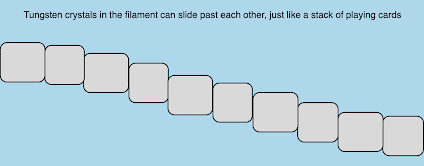It looks rather abstract – a 6” wide by 8” high bronze-colored metal plate rising from a 1-1/4 inch high wooden base. There also is a black object sticking up above it. A side view shows the 1/ 4” thick plate is curved and is held in a groove cut into the wooden base.
The ‘sculpture’ was an accident. It was made in Ann Arbor, Michigan at the Climax Molybdenum Company research laboratory in the early 1980s. Our blacksmith was putting a 6” wide piece of red-hot steel plate into the rolling mill for one of my projects. He was holding the back end with a pair of tongs. The tongs touched the feed table. They got pulled out of his glove-covered hands and went through the rolls along with the plate. That curved black object is what remains from half of his tongs. I have that ‘sculpture’ sitting on the window sill in my office as a reminder that in research you will encounter new things – both desirable and undesirable.
Over a century ago at General Electric William F. Coolidge figured out how to manufacture lamp filaments from tungsten power, as described earlier this year in an article by Ainissa Ramirez at
American Scientist titled Tungsten’s brilliant hidden history. He and his coworkers eventually figured out how to make filaments that lasted for a long time.
The crystals in some filaments grew until they filled the entire diameter of a wire, which resembles a bamboo rod, as shown above.
Under their own weight those large crystals can slide past each other (creep) like a stack of playing cards (as shown above) to produce rapid failure by ‘offsetting.’
The crystals in other filaments did not grow nearly that large, and they maintained an interlocking structure which prevented offsetting. Careful chemical analysis revealed that ‘doping’ the tungsten with a combination of very small amounts of aluminum, potassium, and silicon could produce the desired structure. This is known as AKS doped non-sag tungsten. In the 1960s electron microscopy revealed that tiny bubbles of potassium were responsible for producing the non-sag behavior.




No comments:
Post a Comment